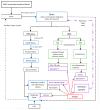The Potential Mechanisms of High-Velocity, Low-Amplitude, Controlled Vertebral Thrusts on Neuroimmune Function: A Narrative Review
- PMID: 34071880
- PMCID: PMC8226758
- DOI: 10.3390/medicina57060536
The Potential Mechanisms of High-Velocity, Low-Amplitude, Controlled Vertebral Thrusts on Neuroimmune Function: A Narrative Review
Abstract
The current COVID-19 pandemic has necessitated the need to find healthcare solutions that boost or support immunity. There is some evidence that high-velocity, low-amplitude (HVLA) controlled vertebral thrusts have the potential to modulate immune mediators. However, the mechanisms of the link between HVLA controlled vertebral thrusts and neuroimmune function and the associated potential clinical implications are less clear. This review aims to elucidate the underlying mechanisms that can explain the HVLA controlled vertebral thrust--neuroimmune link and discuss what this link implies for clinical practice and future research needs. A search for relevant articles published up until April 2021 was undertaken. Twenty-three published papers were found that explored the impact of HVLA controlled vertebral thrusts on neuroimmune markers, of which eighteen found a significant effect. These basic science studies show that HVLA controlled vertebral thrust influence the levels of immune mediators in the body, including neuropeptides, inflammatory markers, and endocrine markers. This narravtive review discusses the most likely mechanisms for how HVLA controlled vertebral thrusts could impact these immune markers. The mechanisms are most likely due to the known changes in proprioceptive processing that occur within the central nervous system (CNS), in particular within the prefrontal cortex, following HVLA spinal thrusts. The prefrontal cortex is involved in the regulation of the autonomic nervous system, the hypothalamic-pituitary-adrenal axis and the immune system. Bi-directional neuro-immune interactions are affected by emotional or pain-related stress. Stress-induced sympathetic nervous system activity also alters vertebral motor control. Therefore, there are biologically plausible direct and indirect mechanisms that link HVLA controlled vertebral thrusts to the immune system, suggesting HVLA controlled vertebral thrusts have the potential to modulate immune function. However, it is not yet known whether HVLA controlled vertebral thrusts have a clinically relevant impact on immunity. Further research is needed to explore the clinical impact of HVLA controlled vertebral thrusts on immune function.
Keywords: HVLA; central nervous system; chiropractic; endocrine system; high-velocity; immune system; low-amplitude thrust; prefrontal cortex; spinal manipulation.
Conflict of interest statement
The authors declare no conflict of interest.
Figures

Similar articles
-
Neuromuscular Response to High-Velocity, Low-Amplitude Spinal Manipulation-An Overview.Medicina (Kaunas). 2025 Jan 22;61(2):187. doi: 10.3390/medicina61020187. Medicina (Kaunas). 2025. PMID: 40005304 Free PMC article. Review.
-
The contemporary model of vertebral column joint dysfunction and impact of high-velocity, low-amplitude controlled vertebral thrusts on neuromuscular function.Eur J Appl Physiol. 2021 Oct;121(10):2675-2720. doi: 10.1007/s00421-021-04727-z. Epub 2021 Jun 23. Eur J Appl Physiol. 2021. PMID: 34164712 Free PMC article. Review.
-
A randomized controlled trial comparing different sites of high-velocity low amplitude thrust on sensorimotor integration parameters.Sci Rep. 2024 Jan 12;14(1):1159. doi: 10.1038/s41598-024-51201-9. Sci Rep. 2024. PMID: 38216596 Free PMC article. Clinical Trial.
-
Neural Responses to Physical Characteristics of a High-velocity, Low-amplitude Spinal Manipulation: Effect of Thrust Direction.Spine (Phila Pa 1976). 2018 Jan 1;43(1):1-9. doi: 10.1097/BRS.0000000000001344. Spine (Phila Pa 1976). 2018. PMID: 26863348 Free PMC article.
-
Effects of thrust amplitude and duration of high-velocity, low-amplitude spinal manipulation on lumbar muscle spindle responses to vertebral position and movement.J Manipulative Physiol Ther. 2013 Feb;36(2):68-77. doi: 10.1016/j.jmpt.2013.01.004. J Manipulative Physiol Ther. 2013. PMID: 23499141 Free PMC article.
Cited by
-
Neuromuscular Response to High-Velocity, Low-Amplitude Spinal Manipulation-An Overview.Medicina (Kaunas). 2025 Jan 22;61(2):187. doi: 10.3390/medicina61020187. Medicina (Kaunas). 2025. PMID: 40005304 Free PMC article. Review.
-
The mechanisms of manual therapy: A living review of systematic, narrative, and scoping reviews.PLoS One. 2025 Mar 18;20(3):e0319586. doi: 10.1371/journal.pone.0319586. eCollection 2025. PLoS One. 2025. PMID: 40100908 Free PMC article.
-
Time to evolve: the applicability of pain phenotyping in manual therapy.J Man Manip Ther. 2022 Apr;30(2):61-67. doi: 10.1080/10669817.2022.2052560. J Man Manip Ther. 2022. PMID: 35344468 Free PMC article. No abstract available.
-
Effect Sizes for Changes in Health and Well-Being Following Treatment With the One-To-Zero Technique in Individuals With Occipito-Atlantal Joint Dysfunction: A Repeated Measures Study.J Chiropr Med. 2023 Dec;22(4):302-312. doi: 10.1016/j.jcm.2023.10.004. Epub 2023 Nov 18. J Chiropr Med. 2023. PMID: 38205225 Free PMC article.
-
Vertebral Subluxation and Systems Biology: An Integrative Review Exploring the Salutogenic Influence of Chiropractic Care on the Neuroendocrine-Immune System.Cureus. 2024 Mar 15;16(3):e56223. doi: 10.7759/cureus.56223. eCollection 2024 Mar. Cureus. 2024. PMID: 38618450 Free PMC article. Review.
References
Publication types
MeSH terms
LinkOut - more resources
Full Text Sources
Medical
Miscellaneous

